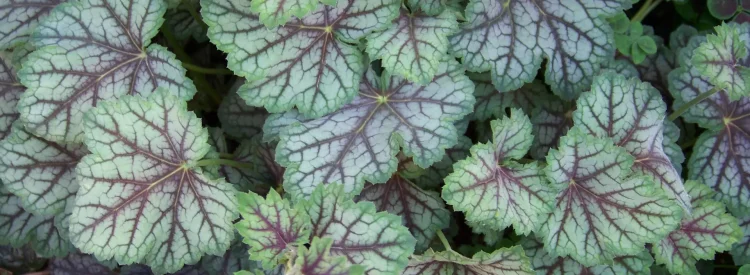Want some color in your shady garden? This is the plant for you. Alum root or heuchera (it goes by a few names) is a short native plant known for its colorful leaf cultivars. They keep their leaves year-round, even in cold climates. Summer brings tall, delicate flower stalks. Heucheras are perfect for shade gardens, super easy to grow, and are easily found at most plant nurseries. Scroll below to find planting tips and a rainbow of heuchera options.
Heuchera is a native plant beloved for many reasons: it’s resilient and evergreen in most climates, and it has cultivars in almost every shade of the rainbow. In this article, we’ll share its benefits, introduce some color options, and share planting tips.
Let’s start by getting the name right. This plant is known by several names.
Heuchera, alumroot, coral bells—these are all the same plant
This plant has many common names: alum root, alumroot (one word), American alum root, heuchera, and coral bells. On The Plant Native, we’ll call it by its Latin genus name, heuchera. No matter what you call it, it loves to be planted in shade or part-shade gardens.
Plant nerd interlude
How do I say heuchera?
It’s pronounced whooo-ker-ah. Imagine you’re a wizened owl from a kids’ movie to get the first sound right (whoooooo likes whoooooo-ker-ah!)
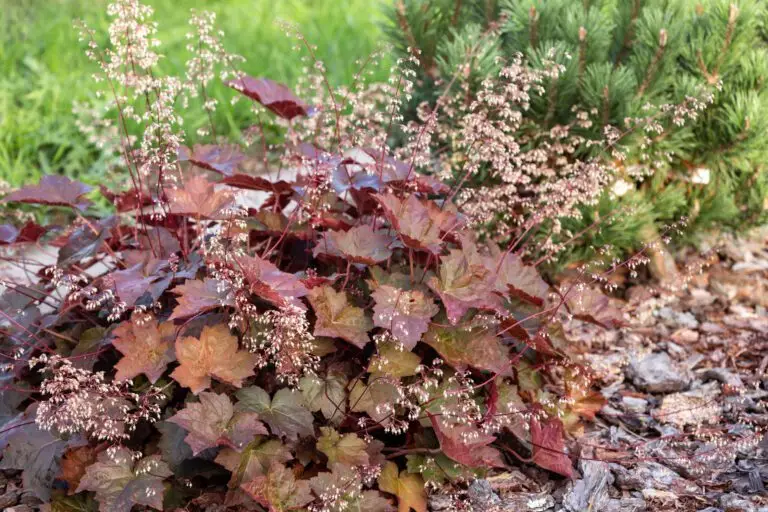
Is Heuchera a good choice for my yard?
Yes, if you’ve got shade and want something that asks for almost nothing in return.
Heuchera is an easygoing native perennial that brings color, texture, and year-round interest—without much work from you. It’s a go-to pick for shady spots and plays well with others in a garden bed.
- Yes, if your yard gets shade or part shade. Heuchera thrives without full sun.
- Yes, if you want color in every season. Many varieties stay evergreen, even in colder zones.
- Yes, if you’re looking for something compact. It tops out around 12–16 inches tall.
- Yes, if you want a low-maintenance plant. No fertilizer, no special soil, no problem.
- Yes, if you want a plant that comes back every year. Heuchera is a true perennial.
Ready for the fun part? Heuchera comes in a whole range of crayon-box colors—from deep purple to chartreuse. Let’s take a look.
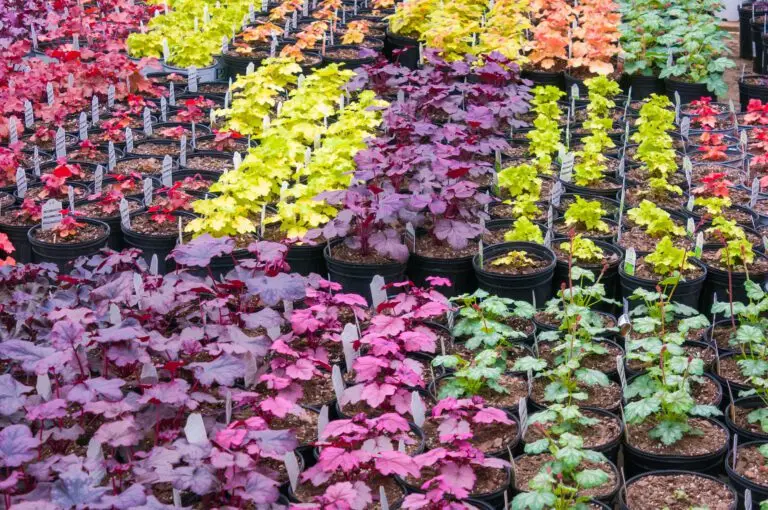
Heuchera cultivars offer a rainbow of leaf colors
It is rare to find the true native Heuchera americana or Heuchera villosa at plant nurseries. The true native species are humble, green-leaved plants that don’t look as showy—and sell as well—as the cultivars.
Enter a hundred years of heuchera cultivars
Since the 1800s, heuchera plants have been bred to create a rainbow of cultivars. (Wondering what a cultivar is? Here’s a short cultivar overview.) Most heuchera cultivars come from H. Americana and H. Villosa. According to the native plant experts in Mt. Cuba Gardens, these plants have “lent hardiness, vigor, and important color components to modern hybrids, transforming shade gardens around the world.”
Heuchera cultivars offer different foliage colors and shapes, from deep purple to vibrant orange, red, and yellow, and from round to ruffled, lobed, or deeply cut leaves. New cultivars are released every year. Here are some nursery favorites:

Heuchera 'Peach Flambé'
Heuchera 'Peach Flambé' sounds and looks like a color of nail polish.
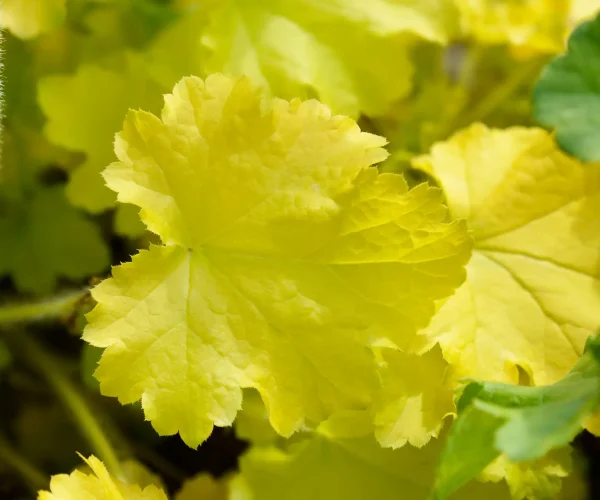
Heuchera 'Electric Lime'
Heuchera 'Electric Lime' does indeed look like a margarita plugged in. Plant this cultivar alongside other green leaf colors to help all nearby plants look extra spectacular.

Heuchera 'Midnight Rose'
Heuchera 'Midnight Rose' reminds you of what a Jackson Pollock painting might look like under a black light.

Heuchera 'Forever Purple'
Plant some Heuchera 'Forever Purple' in your yard, and neighbors will not believe it's real.
Which heuchera should you plant?
The answer to this question at The Plant Native is always the same: plant what you love and plant what you find. Sometimes finding a very specific native plant can be difficult. It’s better to visit your local native nurseries with an open mind. Oftentimes, what you find is even better than what you had hoped for.
If you’re looking for heuchera cultivars that will do the best in your garden…
Mt. Cuba Center—the largest native plant garden in America—looked at 83 different cultivars and found ten heuchera cultivars that stood out.
According to Mt. Cuba: “After three years of evaluating plant habit, vigor, bloom time, flower color, sun tolerance, pest and disease resistance, and overall adaptability, ten cultivars stood out as top performers.”
These heuchera cultivar stars are: ‘Citronelle’, ‘Bronze Wave’, ‘Cajun Fire’, ‘Color Dream’, ‘Steel City’, ‘Caramel’, ‘Apple Crisp’, ‘Frosted Violet’, ‘Southern Comfort’, and ‘Spellbound’.”

Plant a few, together!
Heuchera cultivars also look great when planted together. The similar heights and rainbow of leaves help their differences shine.
What are some good places to plant heuchera?
Plant heuchera in borders, entryways, containers, and garden edges.
Heuchera are low-lying plants (around 6-16″ tall), so plant them along the edge of your garden to see them shine. (They can disappear behind taller plants.) They work great in front walkways and entryways; their mostly evergreen leaves keep your front door verdant. Heucheras are also great in containers and window boxes.
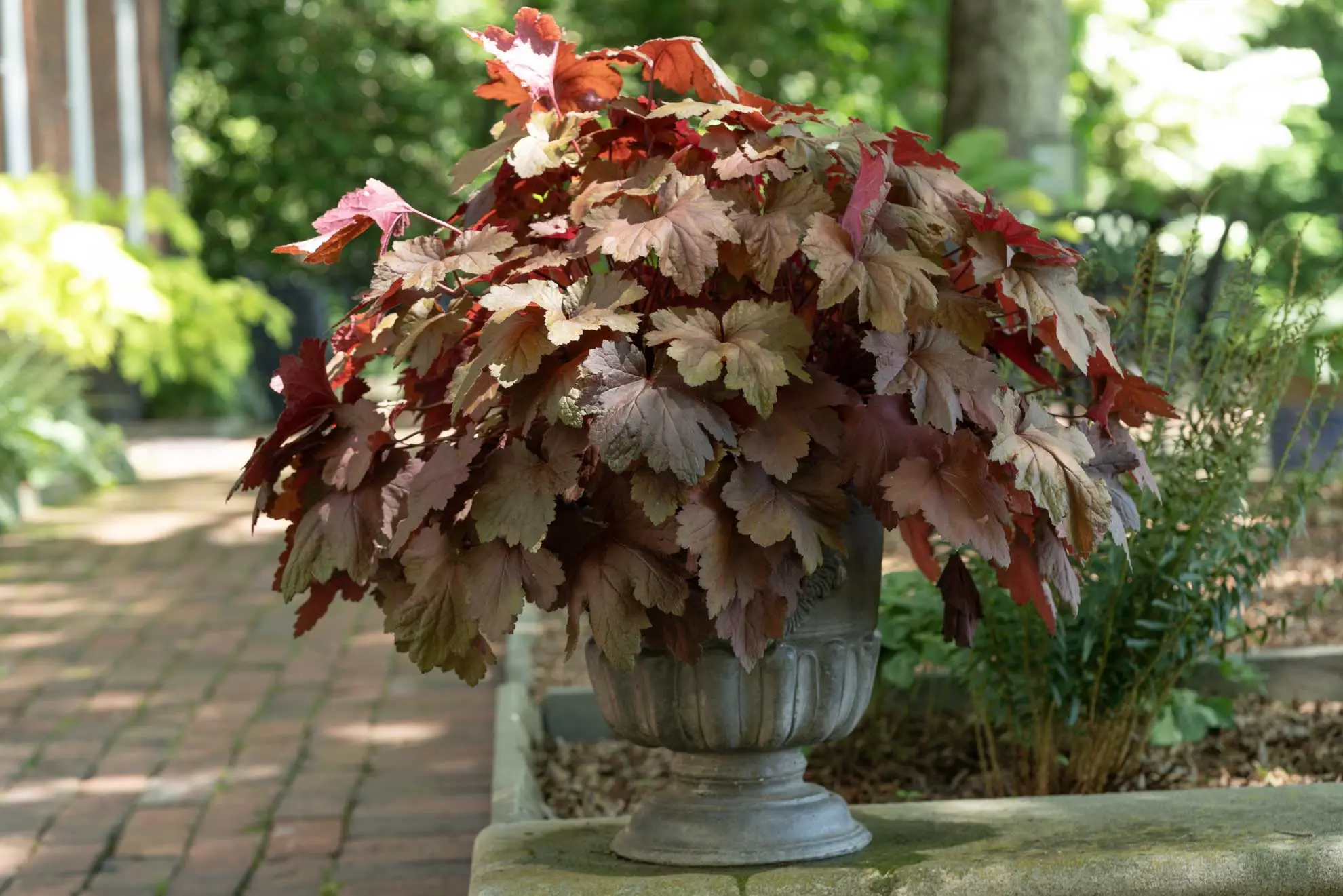

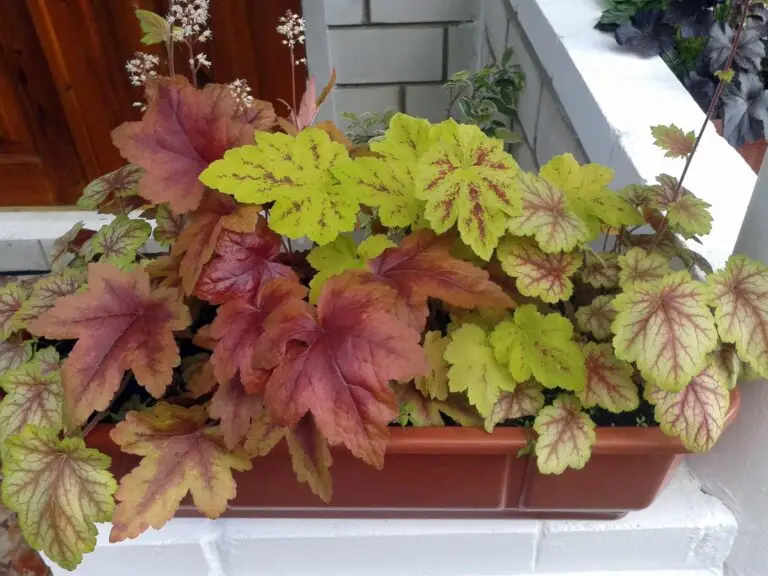
Planting FAQs
When do heuchera bloom?
Heuchera blooms in the late spring/early summer. Their blooms are delicate spikes of tiny white flowers.
Is heuchera evergreen—even in the winter?
Yep! Heuchera keep their leaves—even in the winter. The leaves in the winter can look a little dreary and scraggly, but they are there. They perk up and grow new leaves in the spring.
Can I grow heuchera by seed?
Heuchera is easy to grow by seed. You can plant them directly in the garden in the fall or start them in small pots in the spring (replant them in your garden when they are big enough.)
Plant by seed in the fall
To plant heuchera in the fall, scatter seeds and loosely throw mulch or dirt over the seeds. Seedlings will emerge in the spring. (Yes, it really is that easy! Remember, native plants have survived for thousands of years without us and our trowels.)
After the seedlings emerge, water them daily for the first two months to ensure they get enough moisture to grow.
Plant by seed in the spring
In the spring, you can start heuchera outside when the soil is warm 65°F (18°C) — or start plants inside.
Grow seeds outside
Take the seeds individually and plant them into holes 1/8″ deep. Water daily for the first two months to ensure they get enough moisture to grow. Watch the seedlings emerge in the spring, grow greenery that summer, and bloom in future summers.
Start seeds inside
Start heuchera inside in small pots under grow lights. When the danger of frost has passed, move the pots outside to get used to the wind/light/environment (this is called ‘hardening’.) Plant after they have been ‘hardened’ for a week. Water daily for the first two months to ensure they get enough moisture to grow.
Where can I find heuchera seeds online?
There are several great places to buy heuchera seeds online (it can be difficult to find them—even at local nurseries.)
- $3.29 for a packet of rainbow cultivars, from Swallowtail Garden Seeds
- $2.99 for a packet of the “Americana” cultivar (gorgeous multi-color leaves) from New Hill Farms
Where is heuchera native?
Within the Heuchera genus are quite a few different plants (a genus is a group of plants with species within it). There are 35 native species of heuchera in North America. The USDA plant directory includes a list of them all. There is even one species native to just Arizona!
In this article, we focus on two plants, which are both called ‘heuchera’ for short. The first is Heuchera americana, and the second is Heuchera villosa. Both of these plants have slightly different native ranges in North America. These plants are where most Crayola-bright heuchera cultivars are derived.

What is Heuchera americana’s native range?
Heuchera americana will grow easily in the Midwest, Mid-Atlantic, some of the Northeast, and most of the South (map from the USDA)

What is Heuchera villosa’s native range?
Heuchera villosa is happiest in a smaller range, from New York to Arkansas.
Where can I find heuchera plants?
You can almost always find heuchera at your local native plant nursery (and sometimes even at big box stores.) Since they are so easy to grow and so fun to look at, you can consistently find heuchera plants for your garden. Here are ways to find or buy heuchera plants:
Where can I find seeds and plants?
Finding native plants can be challenging (we partly blame Marie Antoinette.) To make it easier, we’ve assembled four sourcing ideas.
300+ native nurseries make finding one a breeze
Explore 100+ native-friendly eCommerce sites
Every state and province has a native plant society; find yours
Online Communities
Local Facebook groups are a great plant source
What pairs well with heuchera?
Heuchera looks great when planted alongside other native plants that prefer shade or part shade, such as native azaleas, celandine poppy, golden alexander, rhododendrons, mountain laurel, foamflower, and some native shade-loving asters.

Pairs well with
To say it simply: heuchera is a stunning shade-loving plant that looks great year-round, thanks to its semi-evergreen leaves. Dozens of leaf colors come from a stream of fun cultivars making it easy to bring color and excitement to your native garden. Enjoy building a crayon box in your shade garden, filled with heuchera colors. Looking for other iconic shade-friendly natives? Visit our Beginner’s Guide to Native Azaleas or our Beginner’s Guide to Native Rhododendrons. Happy planting!
Sources
- Holm, Heather. Pollinators of Native Plants. (2014), 88.
- Johnson, Lorraine. 100 Easy-to-Grow Native Plants for American Gardens in Temperate Zones. (1999), 101.
- Harstad, Carolyn. Go Native! Gardening with Native Plants and Wildflowers in the Lower Midwest. (1999), 209-210.
- Mt. Cuba Center. “Heuchera Trials.” https://mtcubacenter.org/trials/heuchera/.
- Mt. Cuba Center. Heuchera Trials: A Comprehensive Evaluation of Heuchera Cultivars. 2021. https://issuu.com/mtcuba/docs/heuchera_report
What if your feed was actually good for your mental health?
Give your algorithm a breath of fresh air and follow us.
